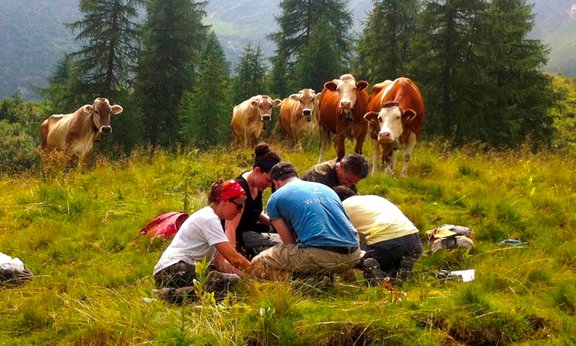“The wealth of microorganisms we found in deadwood was astounding”, says the microbiologist Judith Ascher-Jenull. It has long been known that soil contains a great amount of such microorganisms. When it comes to deadwood slowly decomposing on forest soil, researchers had previously assumed that its decay was mainly driven by fungi. The results of the FWF-funded project Climate-driven Degradation-Dynamics of Deadwood in Alpine Soils suggest otherwise. Actually, there seems to be a synergetic interaction between fungi, bacteria and archaea. “This research outcome lays the foundation for future studies on the interaction between fungi and bacteria in deadwood and their impact on the soil carbon balance and, thus, the productivity of forests”, explains the principal investigator Heribert Insam from the Department of Microbiology at the University of Innsbruck.
Investigating microbial communities
It is well known that forests play an important carbon sink role and thus occupy an eminent position in the context of global climate change. Carbon is not only stored by trees, but also by the forest floor. Many aspects of the carbon cycle are, however, still largely obscure. “We want to understand the system”, notes Insam. Why this is important is clear: “Forests are part of the global carbon pools which can be either bound in the soil or in biomass or out there in the atmosphere. The question that arises is how does climate change impact the decay of wood”, the microbiologist elucidates further. In order to pursue this issue, the team from Innsbruck co-operated with geologists, dendrochronologists (experts determining the age of wood) and modelling experts in the context of the international DecAlp project at Val di Rabbi in the Italian Trentino province. There, the researchers investigated the structure and function of microbial communities along selected altitudinal climosequences at ten study sites, both north- and south-facing, at altitudes between 1,200 and 1,400 meters above sea level. Insam and his group, consisting of Judith Ascher-Jenull, María Gómez-Brandón and Tommaso Bardelli, employed state-of-the-art techniques and instruments. “Deadwood research has been an issue for decades, probing what happens in and under the wood. But only the advent of molecular methods enabling us to gather data on the microbiota made it possible now to characterise bacterial processes”, notes Insam.
Temperature as a driving factor
“The assumption was”, Ascher-Jenull goes on to explain, “that fungi had a priori an advantage when it comes to wood decay. We have now been able to demonstrate that nitrogen-fixing bacteria are active in deadwood and feed nitrogen to the fungi.” This has an immediate impact on the decaying of the wood and the storage of carbon. The fungi are driven, as it were, to top performance through the boost from the bacteria. “We were also able to demonstrate”, Insam continues, “that decay is faster on north-facing than on south-facing slopes.” A surprising result which shows that humidity is more important than temperature. And what does that mean with respect to climate change? Will higher temperatures with the associated lesser availability of water lead to slower decay and less carbon being stored in the soil? “Our study is just one piece in a jigsaw puzzle”, cautions Insam. The trial is now being pursued in the Apennine region as well, where there are different trees – beeches rather than larch trees – and a different climate. More global conclusions will be possible only on the basis of a meta-study including the results from Val di Rabbi, the Apennines and other research projects.
For the time being the project has furnished the insight that deadwood in a forest is not merely essential for insect life, but probably plays a much more vital role in the composition of forest floors and their functioning as carbon sinks. – Which is the reason why it should be allowed to remain in the forest.
(scilog)

